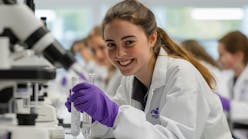What are some of the most difficult clinical sample types for sequencing-related projects and why?
Patient tissue is predominantly preserved as formalin-fixed, paraffin-embedded (FFPE) samples because the sample type is optimized for histology-based diagnostics and enables more cost-effective room temperature storage. However, the method is known to severely compromise the quality of nucleic acids. In fact, FFPE tissue samples are some of the most challenging to use for sequencing projects. The chemical fixation and harsh nucleic acid extraction processes impart extensive damage on already limited quantities of DNA. Depending on the preservation protocol, sample age, and extraction method used, FFPE DNA may incur varying degrees of damage, from crosslinking and fragmentation to nicks, gaps, abasic sites, cytosine deamination, and oxidative damage.
How do the challenges that clinical laboratories face with these sample types impact downstream processes and results?
Clinical laboratories often need to perform all required tests on limited quantities of tissue. This is particularly challenging when only small quantities of often highly damaged DNA are available. The damage present in FFPE DNA is problematic for two major reasons:
Low sample quality increases failure rates: DNA damage can inhibit the activity of enzymes required for the preparation of next-generation sequencing (NGS) libraries, limiting the rate of conversion of DNA molecules into the sequencing library. As a result, FFPE DNA libraries can suffer from insufficient molecular diversity and sensitivity to reliably detect patient mutations. Compounding this challenge, the impact of DNA damage on sample quality can be highly variable, so clinical labs face higher failure rates for library preparation when using a single protocol for all samples.
Damaged FFPE DNA can result in false positives: Several types of damaged DNA bases, notably deamination and oxidative damage, result in sequencing artifacts that present as false positives. The abundance of false positives makes the bioinformatic analysis of FFPE samples particularly complex.
What recent innovations to NGS should clinical labs be aware of pertaining to challenging clinical samples?
FFPE DNA samples still typically require higher DNA input than high-quality samples. However, increasingly efficient methods of NGS library preparation have resulted in higher data quality from increasingly low FFPE sample input amounts. Additionally, the cost of sequencing continues to decrease. Cheaper sequencing is now enabling many labs to explore the utility of whole genome sequencing, when previously, they were constrained to targeted sequencing with hybrid capture panels or amplicon-based methods. The increasing adoption of spatial genomic approaches is another exciting application for which pre-fixed tissue samples, such as FFPE, are already well suited.
What role has New England Biolabs played in the development of solutions for NGS library preparation from clinical samples like FFPE (formalin-fixed, paraffin-embedded)?
At NEB, we’ve developed several new enzymatic solutions to address the challenges posed by FFPE samples, including a new enzymatic DNA repair mix, enzymatic DNA fragmentation mix, and PCR master mix. We have combined these solutions into an NGS library preparation kit — called the NEBNext UltraShear FFPE DNA Library Prep Kit — which was designed to be streamlined and sample quality agnostic, a key feature for clinical labs that often have no control over sample quality or the ability to tweak protocols based on individual samples.
This workflow converts more damaged DNA into the NGS library, enabling higher coverage and, therefore, higher sensitivity for patient mutation detection. Furthermore, the kit improves library quality metrics — such as mapping rate, chimeric reads, and properly paired reads — increasing the amount of usable data for higher sensitivity and more cost-effective sequencing. Finally, the repair of DNA damage reduces sequencing artifacts, increasing the confidence in variant calls obtained from FFPE DNA. While the workflow provides many benefits for challenging samples such as FFPE, it is also compatible with high-quality DNA samples, allowing for the convenience of using a single kit regardless of the sample type obtained.
What elements of your approach lend themselves to successful innovation?
Our expertise at NEB lies in enzymology. We focus on ways we can leverage our deep knowledge of the unique properties of each enzyme in our portfolio to address molecular biology challenges, such as the many damage types in FFPE DNA. Not simply removing but fully repairing damaged DNA bases in a highly specific way enables accurate sequencing data, while also allowing researchers to maximize the diversity of DNA molecules present in their patient samples. Additionally, our new enzymatic fragmentation solution NEBNext UltraShear was designed specifically with FFPE samples and clinical laboratories in mind, improving the quality and quantity of usable data, as well as providing a convenient, automation-friendly workflow for clinical labs.






